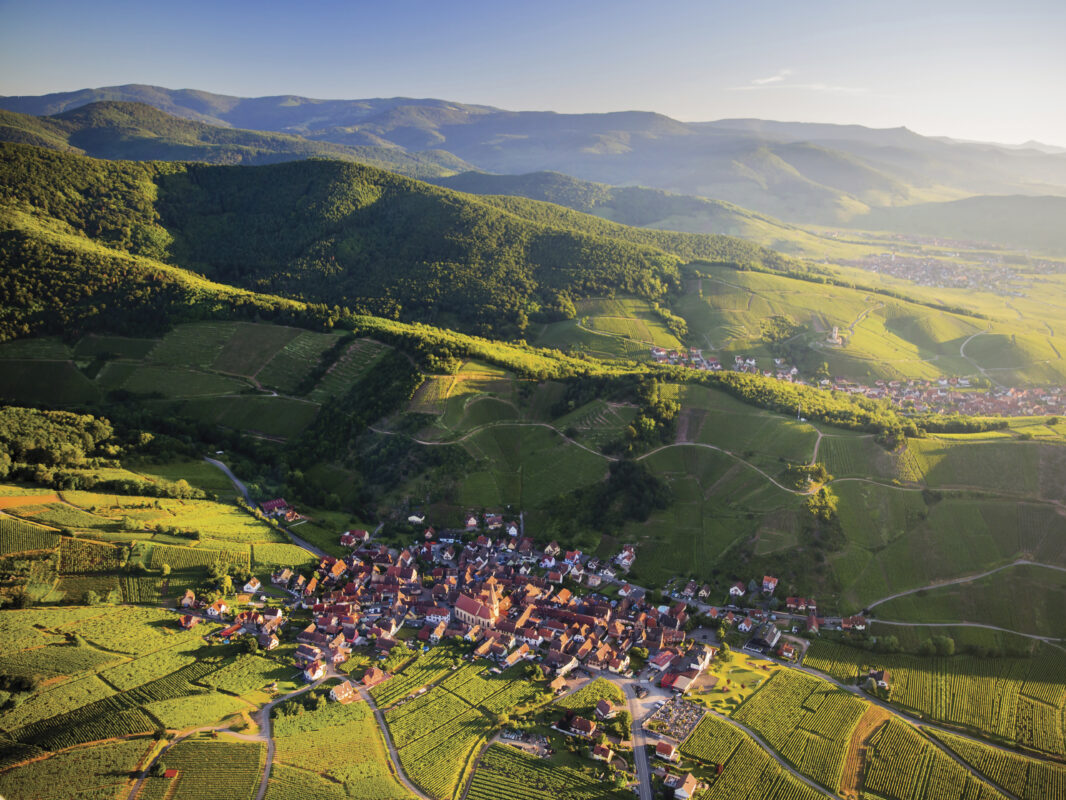For visitors to Alsace, an appreciation of a strong sense of identity is one of the key takeaways. At the top of the list of things for which Alsace is known, there’s food and wine: specifically, excellent white wine to complement regional gastronomic delights such as choucroute (sauerkraut) and Kugelhopf, the traditional spongy raisin-dotted ring cake.
Bordered by Switzerland and Germany, this eye-catching corner of northeastern France is marked by gentle rolling landscapes, medieval villages where colorful flower boxes adorn half-timbered houses, 800-year-old churches, clock towers, hundreds of impressive castles, and plenty of agriculture.
Two international airports serve the region: Basel-Mulhouse-Freiburg and Strasbourg-Entzheim. Alternatively, get there via frequent service on the TGV fast train from Paris, departing from Gare de l’Est and arriving at Strasbourg in less than two hours.
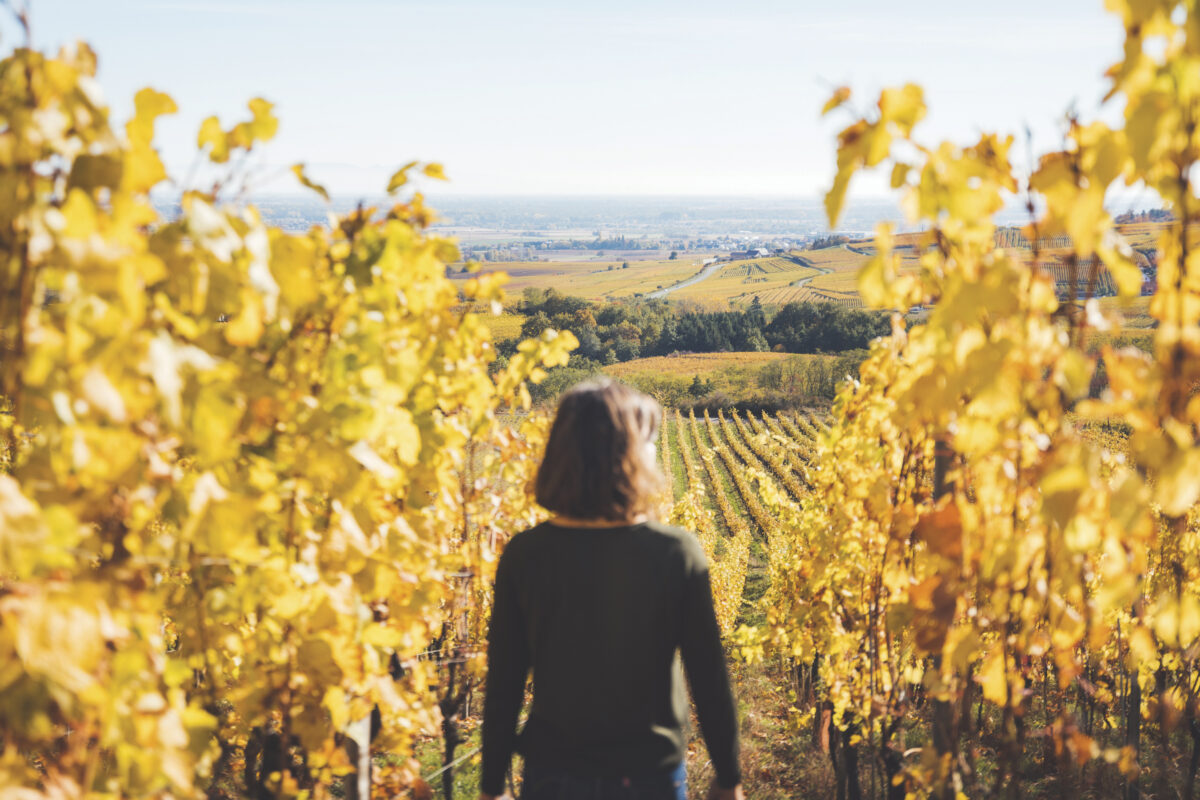
Balade dans le vignoble // Photo courtesy of Visit Alsace
HALLMARKS OF THE ALSACE WINE REGION
The Vosges mountains create a curtain between Alsace and the rest of the country, giving this region the least rainfall in France. The soils are limestone, sandstone, and clay-marl in vineyards at an altitude of approximately 650 to 1200 feet. A late season allows for slow and progressive ripening. About 90 percent of the wine from Alsace is white; the four “Noble Grapes of Alsace” are Riesling, Gewürztraminer, Pinot Gris, and Muscat.
When the vine is at least ten years old, with deep enough roots to nourish the grapes with all the elements of the terroir, the Alsace Grand Cru AOC classification is permitted. Only the best juices from single estates are used for the production of Grands Crus, for which Alsace is known.
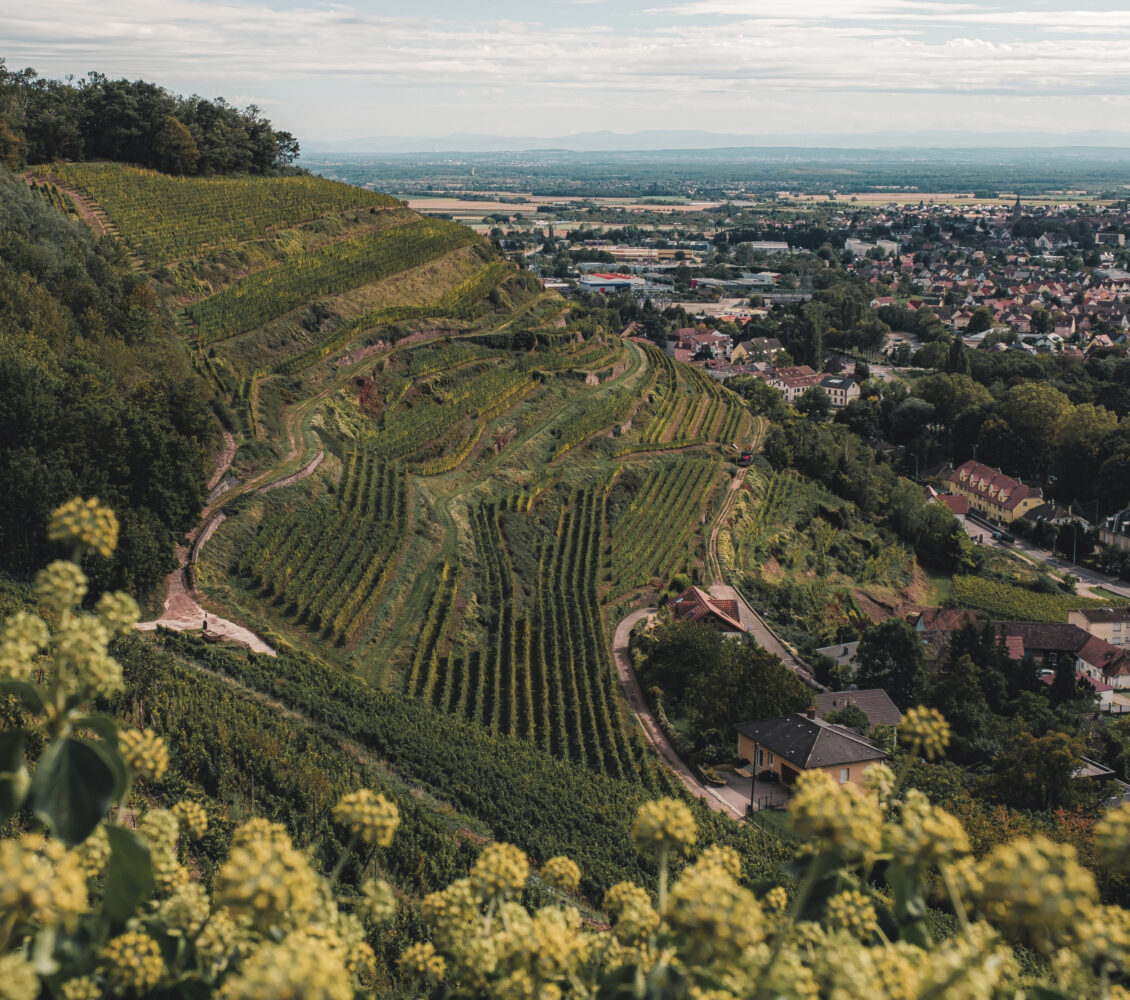
Guebwiller
THE ROUTE DES VINS D’ALSACE
Stretching across fertile Rhine River plains and framed by the foothills of the Vosges mountain range, the Alsace Wine Route is ideal for sightseeing and tasting. As wine routes go, this one, founded in 1953, is a delightfully manageable 105 miles between Marlenheim and Thann. Some drive it, some hike it, and others cycle it at a leisurely pace.
Centered around the market town of Colmar, the route encompasses 720 wine producers, passing through 119 wine-growing villages, including Wissembourg, Obernai, Ribeauvillé, Riquewihr, and Guebwiller. Be sure to stop in some of France’s favorite villages (as voted by locals, according to the tourist board) — Eguisheim, Bergheim, and Kaysersberg, the birthplace of Nobel Peace Prize winner Dr. Albert Schweitzer.
Along the way, 388 independent operators display the welcoming badge, “Vignobles & Découvertes,” to indicate that hospitality and quality experiences await a visitor. Those who have toured along this classic route indicate that friendly one-to-one encounters with locals, including winemakers, are among the great pleasures of the Alsace Wine Route. // www.wineroute.alsace
SLOW UP ON A BIKE
Cycling enthusiasts can choose from 50 biking itineraries of 4 to 12 miles, each marked easy, intermediate, or challenging, including 20 routes especially for mountain bikers. The Alsace Vineyard Cycle Route makes it simple to rent a bike or an electric bike at one of 36 local tourist offices before heading out with or without a guide for anywhere from a few hours to a few days.
Watch for the green “Accueil Vélo” (cyclists welcome) badge, a nationwide symbol for bike-friendly establishments that can provide storage facilities and equipment, such as a puncture repair kit.
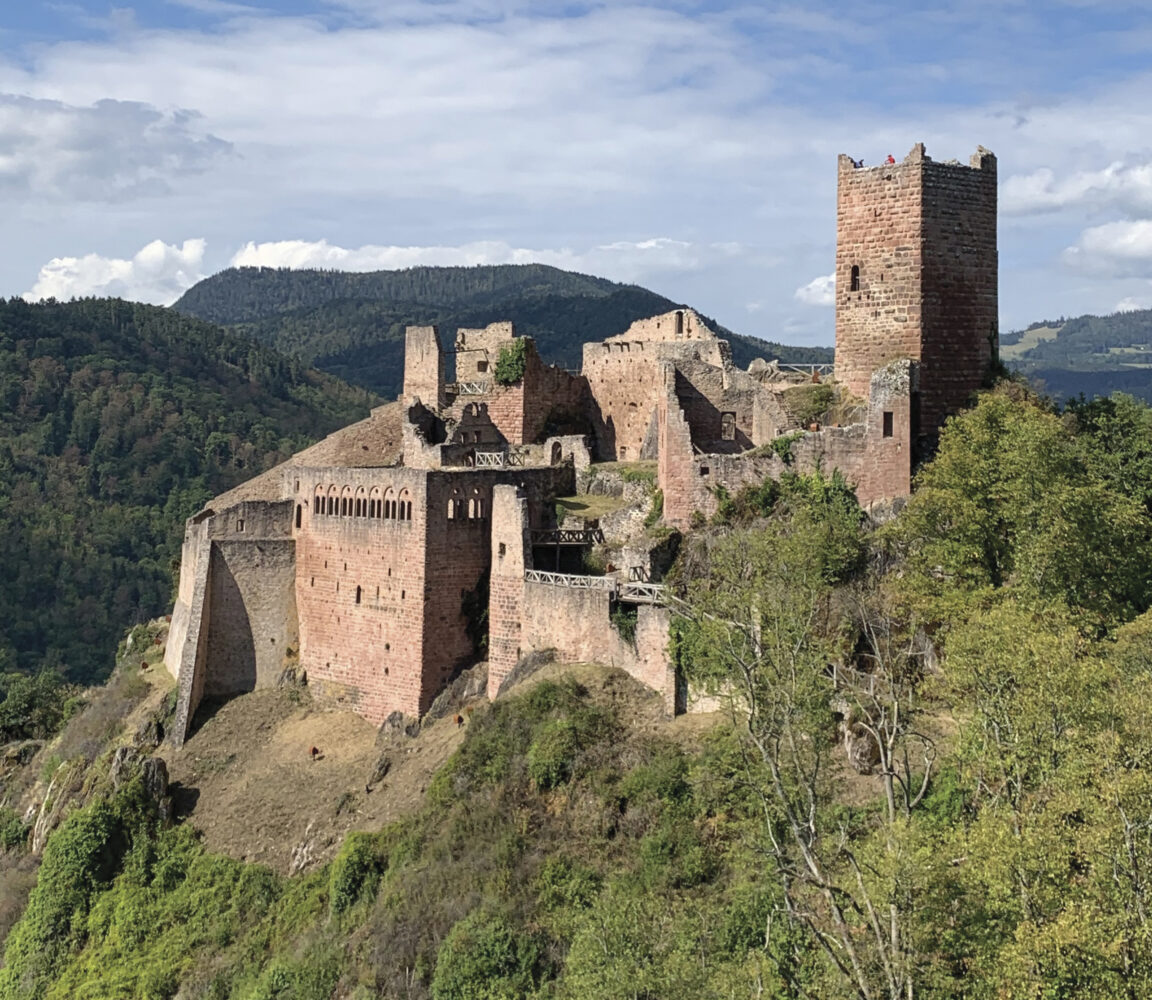
Ribeauville Chateau Saint Ulrich // Photo courtesy of Visit Alsace
TASTING ALONG THE ALSACE WINE ROUTE
Alsace awaits, but in the meantime, among the seven grape varietals and 51 Grand Crus of Alsatian wines, several labels are readily available in California. The regional tourism board suggests visiting these five Alsace wine producers.
Domaines Schlumberger: In Guebwiller, visit the century-old cellars and taste for an hour or two. Longer visits include a 4×4 vehicle tour of the vineyards. Four Grand Crus (including Riesling, Pinot Gris, and Gewürztraminer) are designated at this historic estate. // www.domaines-schlumberger.fr
La Cave de Ribeauvillé: Eight Grand Crus are cultivated at an exceptional vineyard in Ribeauvillé, one of the oldest medieval towns. The winery offers walks through the vineyards, visits to the cellars, and tastings. // www.vins-ribeauville.com/la-cave
Hugel & Fils: In the heart of the 1,000-year-old city of Riquewihr, access to the cellars and tasting room at this 12th-generation family-run business is accessible only on foot. Gewürztraminer, Riesling, Pinot Gris, and Pinot Noir vines on 65 acres are up to 70 years old. // www.hugel.com
Domaine Barmès-Buecher: Learn about high-quality, certified biodynamic wines in the ancient convent town of Wettolsheim at a small production winery. Taste Grand Crus, Pinot Noir, a Crémant Brut, and more. Family-owned since 1985, visits are by appointment. // www.barmes-buecher.com/en
Jean-Baptiste Adam: In 2023, selected by Wine & Spirits for the top 100 worldwide, the business is now in the hands of the 15th generation. Highlights include biodynamic practices for the past two decades and, in 2007, the introduction of Kaefferkopf as the 51st Grand Cru of Alsace. Visit in the heart of Ammerschwihr. // www.jb-adam.com/en
ONLY IN ALSACE
No visit to Alsace is complete without a meal of authentic choucroute garnie, as the generous sauerkraut dish is called in French. In Eastern France, the traditional dish that calls for vegetables, pork, sausage, and bacon, plus a half-bottle of Riesling, is typically cooked and served in an earthenware casserole.
Tarte flambée straight from a wood-burning oven is a local specialty that’s made for sharing at lunch or dinner. Try it in the birthplace of this dish, Kochersberg, where the tradition is passed down from generation to generation in some establishments.
For six weeks from late November, Alsatian outdoor Christmas markets fill the air with the aroma of delicious treats for strolling among wooden chalets decked out with fairy lights. Beside the cathedral since 1570 and now with more than 300 stalls, the Strasbourg Christmas market is among the world’s biggest and oldest. Other unmissable markets are in Colmar, Mulhouse, Obernai, Kaysersberg, and Ribeauvillé. // www.christmas.alsace/strasbourg-christmas-market
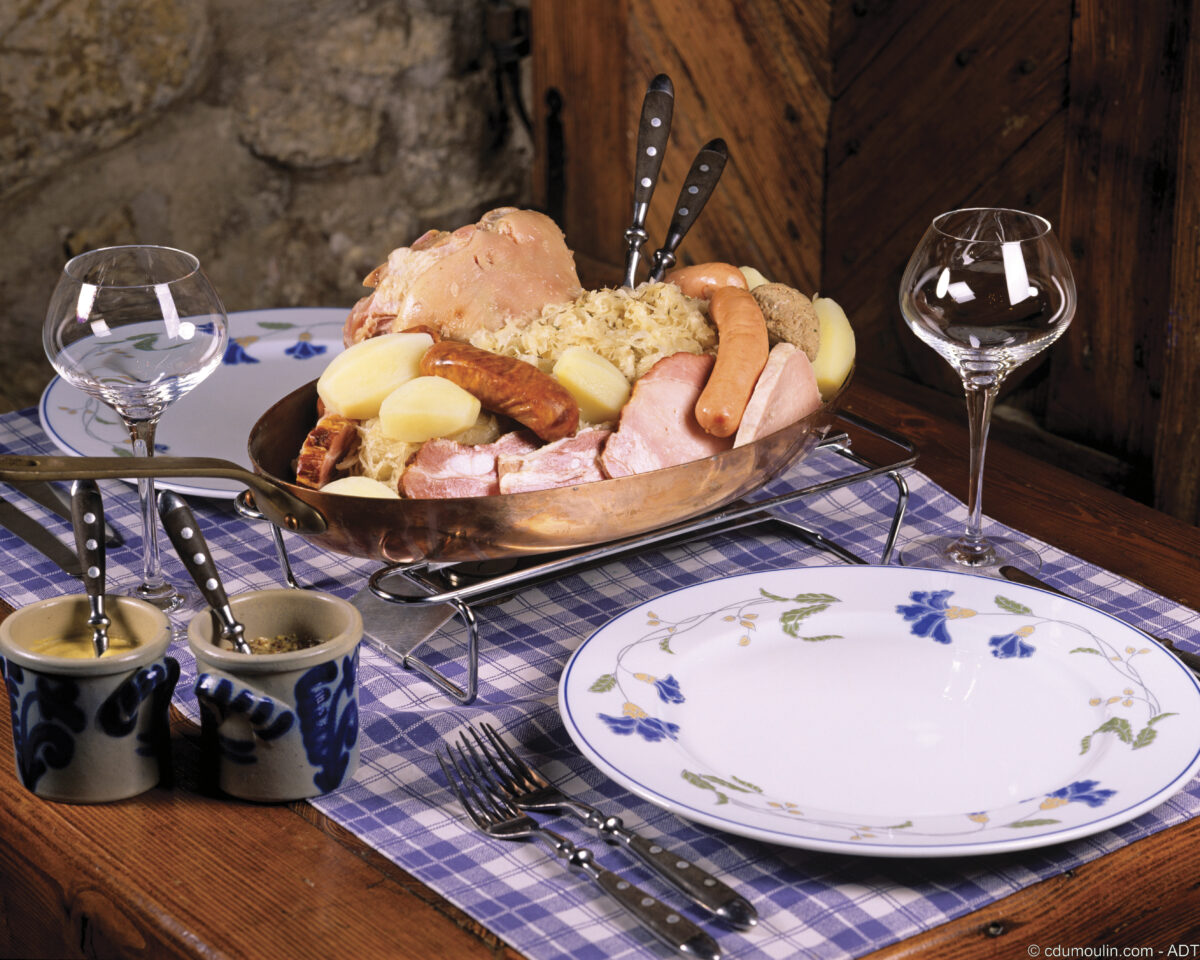
Choucroute // Photo by Christophe Dumoulin courtesy of Visit Alsace
WHERE TO EAT AND STAY
Why not dine and sleep in the same establishment? Perhaps it’s a fairy tale-inspired inn; maybe it’s a castle. When traveling, it’s simple for planning purposes, relaxing, and easy to find these throughout Alsace, with breakfast included as a bonus. Also, keep an eye out for places called winstub, which is a café or restaurant in Alsace that specializes in wine with food, sometimes sporting a Michelin Bib Gourmand or star designation as well. The guide Relais & Chateaux (www.relaischateaux.com/us/destinations/europe/france/alsace-lorraine) is another excellent source for creative cuisine combined with comfortable accommodation under the same roof.
Visit Alsace (www.visitalsace.com), the official tourist bureau, lists hundreds of places to stay, many with traveler ratings. On their website, use the filter to select preferences for onsite restaurants, spas, golf, pool, and other amenities. For wine lovers, there are 83 Alsatian accommodations situated in vineyards. // www.visit.alsace/en/hotels-in-alsace/#vineyard

